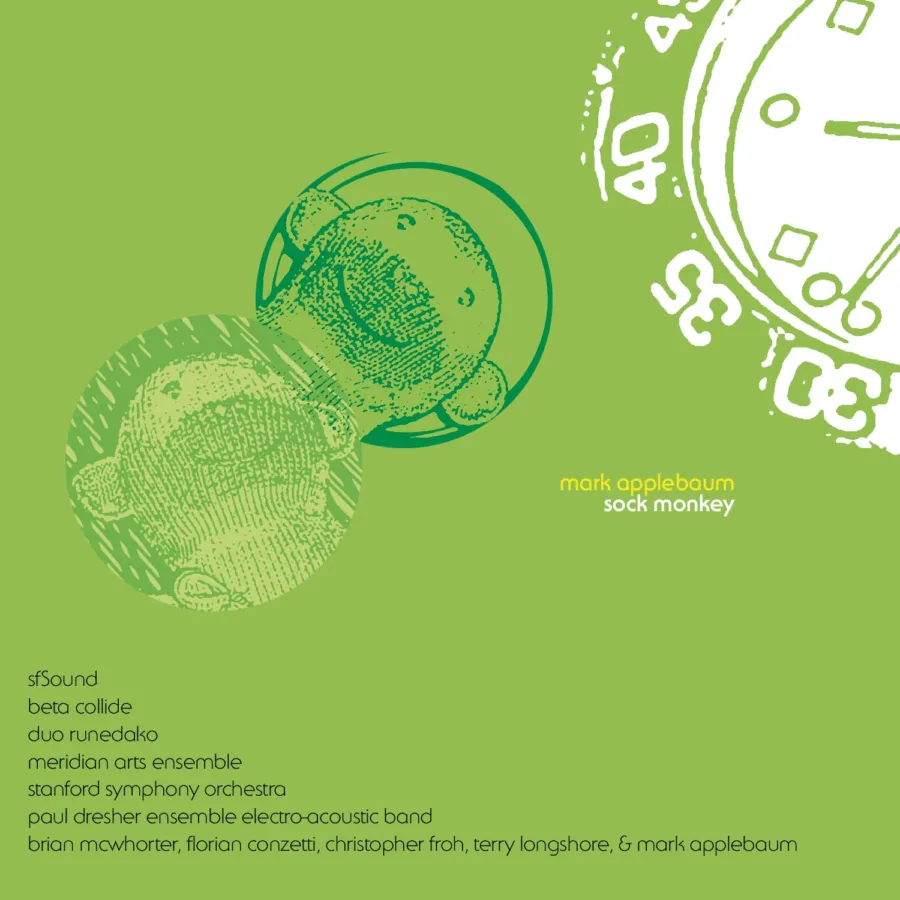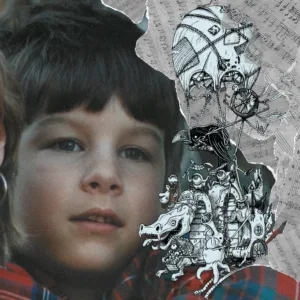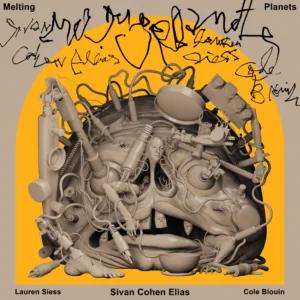In an amusing and well-written autobiographical note included in the beautifully produced 20-page booklet accompanying this latest offering from Mark Applebaum (b. Chicago, 1967), the composer writes: “Some of his music is composed according to painstaking and thorough, if dreary, techniques defended by sober, sensible and defensible logic resulting in characteristics like authenticity, integrity, depth, merit and seriousness, qualities that tend to make modernists happy, or at least comfortable. [..] Recent works, however, tend increasingly toward absurdity. In retrospect (or historical revision), Applebaum’s aesthetic relies on acts of musical collision.” Sock Monkey, the follow up to 2004’s Catfish (Tzadik), and the latest of a whole string of albums on Innova, starts off with a fine example of Applebaum’s exuberant postmodernism, in the form of Magnetic North (2006), a 14-minute adventure scored for brass quintet and percussion with occasional interpolated cadenzas from an additional soloist, in this case Applebaum himself on his self-designed mouseketier (an electroacoustic sound sculpture incorporating amplified bits of junk and toys, whose already strange sounds are further transformed electronically). The score – extracts from which appear in the booklet – uses various forms of traditional and graphic notation, and also calls on the performers to engage in various other activities, including tearing up bits of paper, dropping ping pong balls, and constructing a “bag mute” made from a ball of tin foil which is rolled around among the musicians and eventually stuffed into a paper sack. One amusing instruction calls for a bar to be repeated x+1 times, where x is the number of times it takes two players to stop playing on protest (!). John Zorn’s game pieces inevitably come to mind, so it’s only natural he gets a mention in Applebaum’s liners. The piece is smart, well-written and superbly performed – but probably funny enough without the trombone belly laugh before the end.
Last year’s The Composer’s Middle Period (I’m a little wary of such titles, I don’t know why) is another hectic 3’25” tour de force written for the sfSound ensemble, here a sextet consisting of oboe, bass clarinet, trumpet, trombone, violin and cello, in which five “materials” – ranging from a graphically notated ensemble “outburst” to intricately scored canonic writing – are repeated five times, in various overlapping configurations. The three pieces entitled Theme in Search of Variations, scored respectively for percussion trio, five-piece and four-piece ensemble, are somewhat less frenetic, but still reluctant to sit still. Once more, virtuosity seems to be the name of the game – this is music which somehow seems designed to impress: why else would the composer include a diagram showing the percussionist’s setup? Light relief of sorts (not that anything on this album is exactly “heavy” enough to warrant any) comes in the form of Variations on Variations on a Theme by Mozart (2006), in which the composer performs the Variations on Ah! Vous dirai-je maman (K.265) – on prepared piano. Not one but eighteen of the beasts, each prepared differently. It’s hilarious stuff, but the liners go rabbiting on about the piece being a “musical collision through transcription of the subset collisions through neuromuscular economy,” or something. Tongue in cheek, perhaps, but probably the kind of spiel you’d expect from someone who studied with Brian Ferneyhough at UC San Diego. Hence the title of Entre Funérailles I (1999), a hypothetical interlude to be performed between two versions of his erstwhile teacher’s Funérailles (for string septet and harp), in this case a tiny (2’21”) but intricate miniature for solo trumpet, expertly handled by Brian McWhorter.
On Martian Anthropology 7 – 9 (2006, again), commissioned and performed by the Paul Dresher Ensemble Electro-Acoustic Band, Applebaum goes rummaging in the toybox once more, with crackleboxes, samplers, and a drumkit featuring pizza boxes, egg cartons and plastic bags. On the Nature of the Modern Age is a little more sedate – as it should be, being an affectionate homage to John Silber, Applebaum’s former composition teacher at UCSD – and is scored for piano duo and live electronics, which are used principally to loop sounds sourced from inside the instruments. The closing title track Sock Monkey (2007) is named after a cuddly toy belonging to the composer’s young daughter Charlotte, which might explain the relatively accessible nature of the writing for the Stanford Symphony Orchestra. It’s clear Applebaum knows his Stravinsky, Bartók and Ligeti inside out, but I wonder what a card-carrying modernist like Ferneyhough would make of those Sacre flourishes at 4’21” and the descending octatonic harp tinkles that set in a minute later. Dogmatic quibbles aside, it’s clear Applebaum knows how to write challenging and entertaining music for the top-notch performers he has access to at Stanford. As he’s a tenured composition professor there, expect him continue doing so for quite some time to come.
– Dan Warburton, ParisTransatlantic








